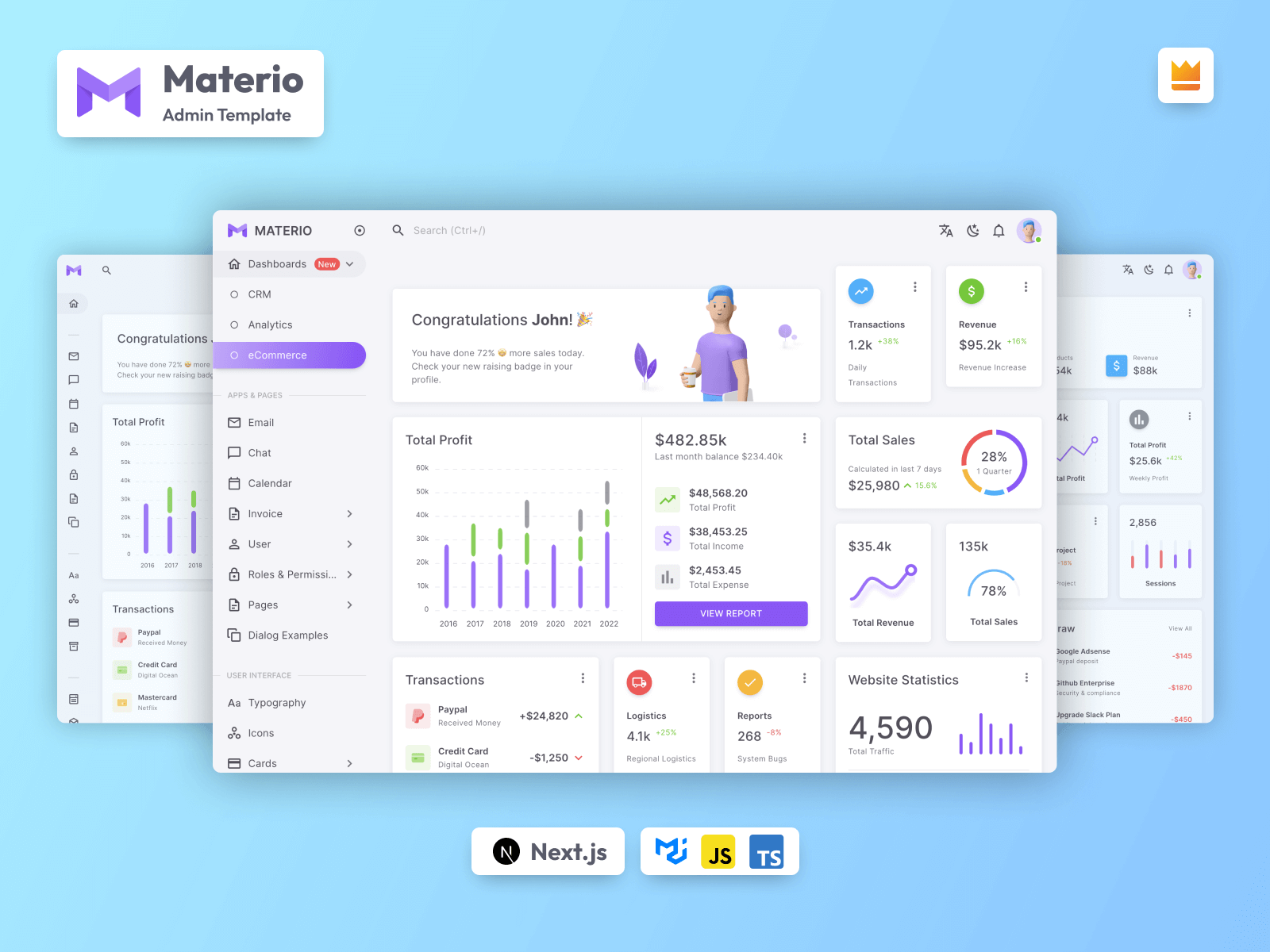In this article, we’re going to compare React and Next.js in terms of popularity, documentation, and performance. You’ll gain a useful perspective on how to choose between them, based on the scale and intended purpose of the application you’re building.
Web technologies are constantly evolving and growing. Despite the shifting JavaScript ecosystem, React and Next.js remain worthy options that have endured for long periods of time.
It’s likely that, as a JavaScript developer, you’ve either recently started using React or have been using it for some time, and you’re also considering Next.js. Understanding the pros and cons of each option is essential for making a good choice.
We created this article in partnership with ThemeSelection. Thank you for supporting the partners who make SitePoint possible.
What is React?
Table of Contents
According to the official React Documentation:
React is a declarative, efficient, and flexible JavaScript library for building user interfaces. It lets you compose complex UIs from small and isolated pieces of code called “components”.
It’s maintained by Meta and a community of individual developers and companies. Its goal is to help developers easily create fast user interfaces for websites and applications alike. The main concept of React is the virtual DOM, where an ideal, or “virtual”, representation of a UI is kept in memory and synced with the “real” DOM by a library such as ReactDOM. Single-page, mobile, and server-rendered applications can be developed using React.
However, React is only concerned with state management and rendering that state to the DOM, so creating React applications usually requires the use of additional libraries for routing, as well as certain client-side functionality.
What is Next.js?
This is how Wikipedia introduces Next.js:
Next.js is an open-source web development framework created by Vercel enabling React-based web applications with server-side rendering and generating static websites.
Next.js gives you the best developer experience with all the features you need for production: hybrid static and server rendering, TypeScript support, smart bundling, route pre-fetching, and more. No config is needed. React documentation lists Next.js among “recommended toolchains”, recommending it for building a server-rendered website with Node.js.
The main feature of Next.js is its use of server-side rendering to reduce the burden on web browsers and provide enhanced security. It uses page-based routing for developer convenience and includes support for dynamic routing. Other features include hot-module replacement, so that modules can be replaced live, automatic code splitting, which only includes code necessary to load the page, and page prefetching to reduce load time.
Next.js also supports incremental static regeneration and static site generation; a compiled version of the website is usually built during build time and saved as a .next folder. When a user makes a request, the pre-built version — which is a static HTML page — is cached and sent to them. This makes the load time very fast, but it’s not suitable for every website — such as interactive sites that change often and utilize a lot of user input.
In order to make professional and responsive web apps, it’s advisable to use ready-made Next.js admin templates, especially when using a new framework or a library. These templates can dramatically reduce development costs and time when starting from scratch.
Materio is built on top of Next.js and MUI. Apart from this, it’s available in both TypeScript and JavaScript versions. It’s developer-friendly, rich with features, and has a highly customizable admin dashboard for building premium-quality, high-performing web applications like SaaS apps, ecommerce apps, fitness apps, CRM projects, and so on.
For a better overview, check out the MUI demo.

Features:
- built with Next.js
- based on React
- built with the MUI core v5 stable version
- 100% React hooks and functional components
- Redux Toolkit and React Context API
- React Hook Form plus Yup
- ESLint and Prettier
- RTL (right-to-left) support
- JWT authentication
- dark and light layouts
- and much more
Difference between Next.js and React
Now, you have enough knowledge about what Next.js and React are. Let’s compare both side by side and list out all the differences.
| Next.js | React |
|---|---|
| Next is a framework for React | React is a library, not a framework |
| You can configure almost everything | Not very configurable |
| Next is famous for server-side rendering and static generation of websites | React doesn’t support server-side rendering out of the box |
| The web apps built using Next.js are very fast | The web apps built using React are slow as compared to Next.js |
| Easier if you know React | A steep learning curve |
| Smaller but very dedicated community | A large community of users |
| SEO-friendly out of the box | Needs some setup to make it SEO-friendly |
| Doesn’t require offline support | Requires offline support |
| Next is opinionated | React is unopinionated |
Pros and Cons of React and Next.js
After looking at the above side-by-side comparison, you probably have some idea about which framework you should choose. But let’s look at the pros and cons of each framework in more detail.
Advantages and Disadvantages of React
Advantages of React:
- easy to learn and easy to use
- uses the virtual DOM
- has reusable components
- SEO-friendly
- offers scalability
- has clean abstraction
- boasts a large and helpful community
- has a rich plugin ecosystem
- provides fantastic developer tools
Disadvantages of React:
- has a high pace of development
- lacks good documentation
- has lagging SDK updates
Advantages and Disadvantages of Next.js
Advantages of Next.js:
- offers image optimization
- offers internationalization
- has zero config
- has fast refresh
- hybrid: SSG (static-site generation) and SSR (server-side rendering)
- has API routes
- offers built-in CSS support
- supports TypeScript
- offers enhanced user experience
- is SEO-friendly
Disadvantages of Next.js:
- has a poor plugin ecosystem
- doesn’t have a built-in state manager
- it’s an opinionated framework
- has file-system based routing
Which one is Better: Next.js or React?
It’s not a pick-one-over-the-other situation, since React is a library used to build UIs, while Next.js is a framework for building an entire app based on React.
The question should always be asked in the context of the app/project requirement.
React can sometimes be more appropriate than Next.js and vice versa. The following use cases will help you decide which one to use and when.
When should you use React?:
- when you need highly dynamic routing
- when you’re already familiar with JSX
- when you need offline support
When should you use Next.js?:
- when you need an all-inclusive framework
- when you need server-side rendering
- when you require backend API endpoints
Conclusion
Despite the popularity of React, Next.js offers server-side rendering, fast loading speeds, SEO capabilities, file-based routing, API routes, and many more unique, out-of-the-box features that make it a very handy choice in many situations. You can achieve the same with React — which provides more control and customizability — but it will require manual configurations.
Thanks for reading our comparison of Next.js and React. We hope you’ve gained a better understanding and will find it easier to choose the right technology for your next application.






